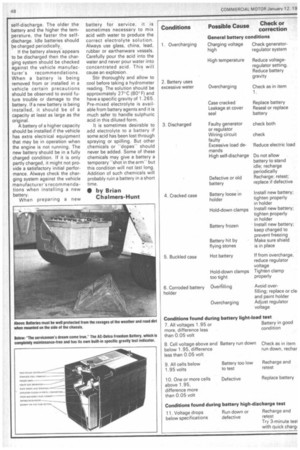itep-by-step tips mit battery service
Page 49

Page 50

If you've noticed an error in this article please click here to report it so we can fix it.
is satisfactory. If however readings for individual cells y by more than 0.040, the tery.has an internal fault and
ther investigation is :essary.
If the cell readings are uni11 but the readings indicate t the battery is less than 70 cent charged, the battery uld be removed for recharg.
Ihe hydrometer test does not :lose the mechanical or elec31condition of the battery but -ely indicates the percentage icid still in the electrolyte. A h discharge test is recomnded by some battery lufacturers because it gives litional information on :ery condition.
iiloisture collects on the top )atteries particularly when are mounted on the chassis not fitted with protective ers. Grime and dust is coled and if it is not periodically ned off, there will finally be ugh to permit the battery to ;harge slowly across the ery top. A convenient way of ning the battery is to tighten plugs, sprinkle or brush ing soda solution on the ery top, wait for the foaming top and then flush off with n water.
,ccumulation of corrosion Ind the cable clamps and )inals is more or less a natur;ondition. To remove the psion and re-establish good connections, first detach the clamps from the battery terminal posts — ground cable first. Use special wire brushes or steel wool to clean the clamps and the terminal posts. Then replace the cable clamps and tighten the nuts, taking care not to overtighten as this could damge the clamp A coating of petroleum jelly or special battery anti-corrosion paste spread on the clamps and posts will retard corrosion.
If the battery cables are badly corroded, if insulation is damaged or if strands are broken or loose, then replace the cables, always using a size at least as large as the original.
Should the battery holder or surrounding area be corroded, then the battery should be removed while the cables are disconnected and all traces of electrolyte removed. Repaint affected areas before refitting the battery.
Battery manufacturers supply full details on how their products should be charged, but normally the charge rate is onetenth of the ampere hour capacity at the 10-hour rate. Continue charging the battery until the hydrometer readings are constant for three successive hourly readings, when all the cells are gassing freely.
Rapid charging requires more careful supervision than for original charging and should only be done in cases of urgency.
However the battery can be brought up to 70-80 per cent charge with no risk of damage providing the current is reduced to prevent the battery temperature from exceeding 43'C (110'F).
With the battery fully charged and the chemical actions completed, further charging of the battery will damage it through loss of electrolyte causing the plates to dry out and harden. High temperatures that may develop in the battery cells as the overcharge continues may cause the plates to buckle, crush the separators and produce direct shorts between the negative and positive plates.
Overcharging while the battery is in use or on the bench being charged is indicated by the battery requiring excessive amounts of water. The charging system should be checked against the vehicle manufacturer's recommendations and any adjustments found necessary carried out.
A discharged battery will not be able to supply enough current for normal engine starting. This is usually the first indication of trouble; if the battery had been periodically checked, progressively lower voltage readings would give early warning that some abnormal condition was developing and the necessary corrective action could be taken before complete battery failure and inability to start resulted.
A battery that is operated for long periods in a partly discharged condition may be permanently damaged. Also a battery that is allowed to sit idle for long periods without attention is apt to run down from self-discharge. The older the battery and the higher the temperature, the faster the selfdischarge. Idle batteries should be charged periodically.
It the battery always appears to be discharged then the charging system should be checked against the vehicle manufac turer's recommendations. When a battery is being removed from or installed in a vehicle certain precautions should be observed to avoid future trouble or damage to the battery. If a new battery is being installed, it should be of a capacity at least as large as the original.
A battery of a higher capacity should be installed if the vehicle has extra electrical equipment that may be in operation when the engine is not running. The new battery should be in a fully charged condition. If it is only partly charged, it might not provide a satisfactory initial performance. Always check the charging system against the vehicle manufacturer's recommendations when installing a new battery.
When preparing a new battery for service, it is sometimes necessary to mix acid with water to produce the correct electrolyte solution. Always use glass, china, lead, rubber or earthenware vessels. Carefully pour the acid into the water and never pour water into concentrated acid. This will cause an explosion.
Stir thoroughly and allow to cool before taking a hydrometer reading. The solution should be approximately 27c•C (80 F) and have a specific gravity of 1.265. Pre-mixed electrolyte is available from battery agents and it is much safer to handle sulphuric acid in this diluted form.
It is sometimes desirable to add electrolyte to a battery if some acid has been lost through spraying or spilling. But other chemicals or "dopes" should never be added. Some of these chemicals may give a battery a temporary -shot in the arm' but this condition will not last long. Addition of such chemicals will probably ruin a battery in a short time.
111 by Brian Chalmers-Hunt
































































































































